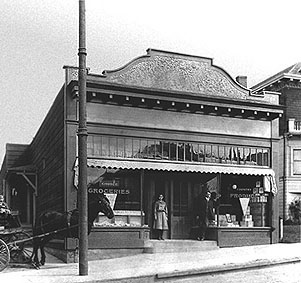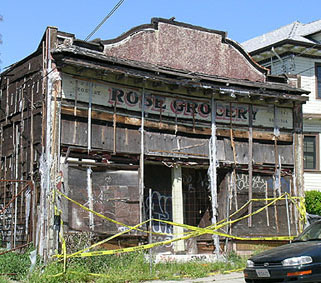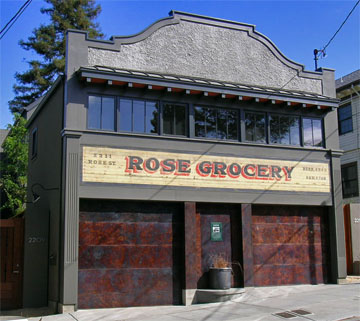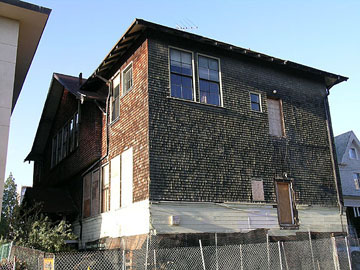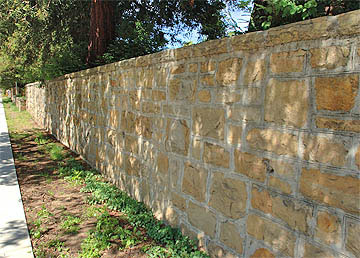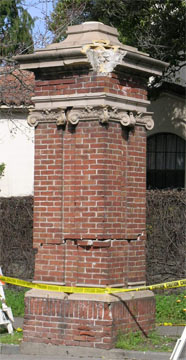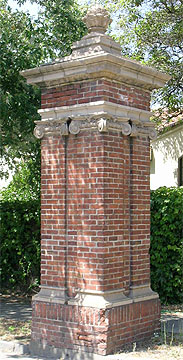BAHA Preservation Awards 2006
Part Three
Commendations
Hunrick Grocery (courtesy of George Hunrick, Jr.)
A wreck in 2004 (photo: Daniella Thompson)
The reconstructed building (photo: Daniella Thompson, 2005)
Hunrick Grocery
2209–2211 Rose Street
(C.R. Madison, builder, 1908)Built for George Hunrick in 1908, the structure was designed as a grocery store with a residence in the rear. Mr. Wing Pon was the last owner to operate a grocery store in this building (from 1960 to 1966). Later he allowed the structure to fall into total decay. The building was boarded up and unused for many years. It was ldesignated a City of Berkeley Landmark, Structure of Merit, in 1988. The existing building was beyond repair, so the developer-architect’s strategy included razing what was left of the existing structure and reconstructing a small new structure at the street that retains elements of the original Mission Revival fa�ade as well as the grocery sign.
McKinley School in an early postcard (BAHA archives)
Awaiting renovation (photo: Daniella Thompson, 2004)
The reconstructed McKinley Hall (photo: Daniella Thompson, 2006)
Haste St. Annex of McKinley School
2407 Dana Street
(A.H. Broad, 1906)First Presbyterian Church dedicated McKinley Hall on Sunday, 25 September 2005. The building originally served as an annex for McKinley School, which was located across the street and faced onto Dwight Way (now site of the USCA’s Rochdale Apartments). The building was used for classes until 1944, when it was converted to twelve apartments for WWII housing. The church acquired it in 1983, and four years later, it was designated a City of Berkeley Landmark, Structure of Merit.
The $25 million, two-year project included construction of the 3-story Geneva Hall and a two-story undreground parking garage, as well as renovation and conversion of the McKinley School building. Church officials originally contemplated demolishing this building, but after hiring Mark Gillem to replace the original project designer, a plan was settled on that turned the building 180 degrees, allowing it to form part of an inner courtyard plaza.
Construction crews lifted the old building, set it down in a corner of the lot, built the undreground garage, then lifted the building again and placed it on top of the garage. Work included a new foundation, seismic upgrades, and a return to the original 13-foot ceilings. McKinley Hall is used for counseling services and youth rooms.
Honorable Mentions
Clark Kerr Campus wall (photo: Carrie Olson, 2006)Clark Kerr Campus Stone Wall
Warring Street
(1900)The north, west, and south sides of the Clark Kerr Campus (formerly the Deaf and Blind School) are marked by a large stone wall topped with a coping. A significant section of the wall along Warring Street gave way, causing large stones to fall onto the sidewalk. This past year, the University rebuilt the damaged portion of the wall, reusing the stones and original coping, although the wall height was lowered to match other lower portions of the surrounding walls. The stones had originally clad the 1867 Deaf and Blind School building, which burned on 17 January 1875. Salvaged and stockpiled, these stones were eventually used to build the wall, which is part of the 1982 National Register of Historic Places designation for the site.
The damaged pillar (photo: Daniella Thompson, 2005)
The repaired pillar (photo: Daniella Thompson, 2006)
Claremont Court Entry Gate Pillar
Derby Street
(John Galen Howard, 1907)A series of classically inspired brick gateways designed by John Galen Howard mark the boundaries of Duncan McDuffie’s elegant Claremont Court subdivision. In 2005, one of the gate pillars on Derby Street was badly damaged by a large truck, which cracked and dislocated the shaft. A large portion of the upper cornice was broken off, and the plaster finial representing a cluster of acanthus leaves was missing.
Discussion followed as to whether to remove the pillar completely. The neighborhood submitted a landmark application for the the Claremont Court gates and street markers, which were designated a City of Berkeley Landmark in May 2005. Shortly after, the City found a contractor who successfully repaired the pillar and replaced the finial.
Awards 2006
Copyright © 2006–2012 BAHA. All rights reserved.

